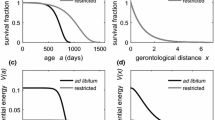Abstract
A specific mortality rate process governed by the non-homogeneous Poisson process of point events is considered and its properties are studied. This process can describe the damage accumulation in organisms experiencing external shocks and define its survival characteristics. It is shown that, although the sample paths of the unconditional mortality rate process are monotonically increasing, the population mortality rate can decrease with age and, under certain assumptions, even tend to zero. The corresponding analysis is the main objective of this paper and it is performed using the derived conditional distributions of relevant random parameters. Several meaningful examples are presented and discussed.



Similar content being viewed by others
References
Anderson JJ (2000) A vitality-based model relating stressors and environmental properties to organism survival. Ecol Monogr 70:445–470
Beard RE (1959) Note on some mathematical mortality models. In: Wolstenholme CEW, Connor MO (eds) The lifespan of animals. Little, Brown, Boston, pp 302–311
Carey JR, Liedo P, Orozco D, Vaupel JW (1992) Slowing of mortality rates at older ages in large medfy cohorts. Science 258:457–461
Cha JH, Mi J (2007) Study of a stochastic failure model in a random environment. J Appl Probab 44:151–163
Finkelstein M (2008) Failure rate modeling for reliability and risk. Springer, London
Finkelstein M (2012a) On ordered subpopulations and population mortality at advanced ages. Theor Popul Biol 81:292–299
Finkelstein M (2012b) Discussing the Strehler–Mildvan model of mortality. Demogr Res 26:191–206
Gampe J (2010) Supercentenarians. Demographic Research Monographs, Ch. III. In: Maier H, Gampe J, Jeune B, Robine JM, Vaupel J et al (eds) Human mortality beyond age 110. Springer, Heidelberg, pp 219–230
Kannisto V, Lauritsen J, Thatcher AR, Vaupel JW (1994) Reduction in mortality at advanced ages: several decades of evidence from 27 countries. Popul Dev Rev 20:793–810
Lemoine AJ, Wenocur ML (1986) A note on shot-noise and reliability modeling. Oper Res 34:320–323
Li T, Anderson JJ (2009) The vitality model: a way to understand population survival and demographic heterogeneity. Theor Popul Biol 76:118–131
Missov TI, Finkelstein M (2011) Admissible mixing distributions for general class of mixture survival models with known asymptotics. Theor Popul Biol 80:64–70
Moolgavkar SH (2004) Commentary: fifty years of the multistage model: remarks in a landmark paper. Int J Epidemiol 33(6):1182–1183
Moolgavkar SH, Luebeck EG (2003) Multistage carcinogenesis and the incidence of human cancer. Genes Chromosom Cancer 38:302–306
Ross S (1996) Stoch Process. Wiley, New York
Shaked M, Shanthikumar J (2007) Stoch Orders. Springer, New York
Strehler L, Mildvan AS (1960) General theory of mortality and aging. Science 132:14–21
Vaupel JW, Manton KG, Stallard E (1979) The impact of heterogeneity in individual frailty on the dynamics of mortality. Demography 16:439–454
Vaupel JW, Yashin AI (1985) Heterogeneity’s ruses: some surprising effects of selection on population dynamics. Am Stat 39:176–185
Yashin AI, Iachine IA, Begun AS (2000) Mortality modeling: a review. Math Popul Stud 8:305–332
Acknowledgments
The authors would like to thank the Editor and the referees for helpful comments and suggestions, which have improved the presentation of this paper. The work of the first author was supported by the National Research Foundation of Korea (NRF) grant funded by the Korea government (MEST) (No. 2011-0017338). The work of the first author was also supported by Priority Research Centers Program through the National Research Foundation of Korea (NRF) funded by the Ministry of Education, Science and Technology (2009-0093827). The work of the second author was supported by the NRF (National Research Foundation of South Africa) grant IFR2011040500026.
Author information
Authors and Affiliations
Corresponding author
Appendix: Proof of Theorem 1
Appendix: Proof of Theorem 1
Proof
Let \(0\le T_1 \le T_2 \le \cdots \) be the sequential arrival times of shocks in the NHPP \(\{N(t), t\ge 0\}\) with rate \(\lambda (x).\) Note that the full history of \(\{N(u),0\le u\le t\}\) can be equivalently specified in terms of \(\{T_1 ,T_2 ,\ldots ,T_{N(t)} ,N(t)\}.\) Then, in accordance with (7), the survival function of an organism given the shocks history is
Observe that the joint distribution of \((T_1 ,T_2 ,\ldots ,T_{N(t)} ,N(t))\) is given by
where, \(\exp \left\{ {-\int _0^{t_1 } {\lambda (u)du} } \right\} \) represents the probability that there is no shock in \((0,t_1 )\), then \(\lambda (t_1 )\) represents the probability that a shock occurs at \(t_1 \), then \(\exp \left\{ {-\int _{t_1 }^{t_2 } {\lambda (u)du} } \right\} \) represents that the probability that there is no shock in \((t_1 ,t_2 )\), then \(\lambda (t_2 )\) represents the probability that a shock occurs at \(t_2 \), and so forth.
Therefore, combining (11) and (12), integrating out \(T_1 ,T_2 ,\ldots ,T_n \) and using the properties of the NHPP, the joint distribution of \(\{T>t,N(t)\}\) is obtained as
where, in calculating the multiple integrals, we used the following property: for any function \(\varphi (x)\),
which can be directly obtained by integrating with respect to \(t_1 ,t_2 ,\ldots ,t_n \), ‘sequentially’.
From (13),
Finally, from (13) and (14), we have
Rights and permissions
About this article
Cite this article
Cha, J.H., Finkelstein, M. On some mortality rate processes and mortality deceleration with age. J. Math. Biol. 72, 331–342 (2016). https://doi.org/10.1007/s00285-015-0885-0
Received:
Revised:
Published:
Issue Date:
DOI: https://doi.org/10.1007/s00285-015-0885-0
Keywords
- Gompertz law of mortality
- Fixed heterogeneity
- Evolving heterogeneity
- Nonhomogeneous Poisson process
- Mortality rate
- Mortality process




